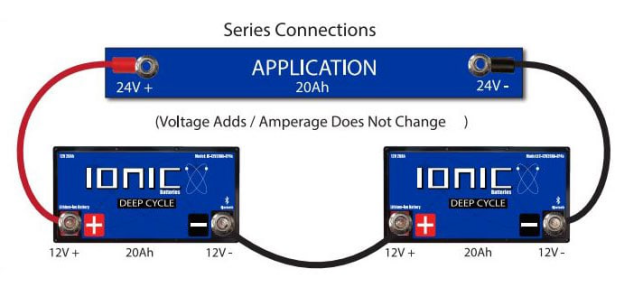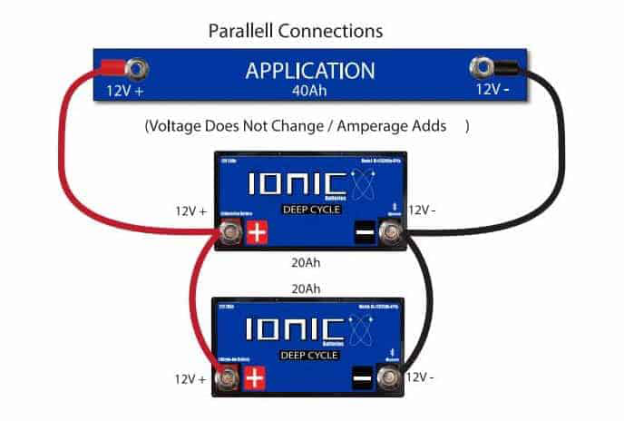Hooking up Batteries in Series
Oct 24, 2022 Pageview:502
Introduction
One or more electrochemical cells with external connections make up the battery, a device used to power electrical gadgets. Depending on the circuit, many batteries are either connected in series or parallel. Understanding the distinction between series and parallel connections is essential because they affect how batteries function in various applications. Let's examine the series and parallel connections of batteries in this article and when either approach is appropriate.
A set of two or more RV batteries connected together in series or parallel form a bank of batteries. By increasing amperage, voltage, or both, you can store more power than would be possible with a single battery. There is occasionally some misunderstanding on this subject, therefore today we'll try to clarify what you need to know about connecting RV batteries in series vs. parallel.
Hooking up Batteries in Series vs Parallel
Both techniques result in an increase in total accessible energy, expressed in watt hours. However, they accomplish this in various ways, and the outcomes vary. The impact on the output voltage and the system's capacity are the key differences between wiring batteries in series and parallel. When batteries are connected in series, the voltages of the batteries are added. The combined amp-hour capacity of batteries that are connected in parallel will be used. But in both setups, the overall available energy (expressed in watt-hours) is the same.
The voltage and capacity ratings of all the batteries in a series or parallel configuration should match. Voltage and capacity incompatibilities can result in issues that could harm your batteries.
Methods for Series Battery Connection
Voltage is increased when batteries are connected in series. The ampere capacity is not increased. For instance, when two 12V 30Ah batteries are connected in series, the total voltage is 24V. The 30 amp hours (Ah) of capacity remain the same.
Before connecting the batteries in series, verify that they have the same voltage and capacity ratings.. Mixing and matching is acceptable for your wardrobe but not when designing your battery configuration! This poses a risk and could harm your batteries.
Here is a step-by-step guide for connecting batteries in series:
One battery's negative terminal should be connected to the next battery's positive terminal.
Once all of the batteries are connected in a line (your "series"), keep connecting them in this manner.
The first battery in the sequence should now have its positive terminal connected to the positive terminal of your application.
Connect the application's negative connection to the negative terminal of the final battery in the series.
Reminder: Multiple batteries can also be charged in sequence. Just be sure the charger you use is compatible with the aggregate total voltage of all of your batteries.
It's crucial to understand this. Ionic lithium batteries can be connected in series in the majority of cases but not always. For more information, read the battery's user handbook.

Methods for Parallel Battery Connection
While wiring in parallel increases battery capacity, wiring in series boosts voltage. The overall voltage remains constant.
This indicates that connecting two 12V 30Ah batteries in parallel would result in a 60 amp-hour battery. It remains at 12 volts.There can be no mixing and matching, just like when wiring batteries in series. The voltage and capacity of each battery in a parallel configuration must match.
Here is a step-by-step guide for connecting batteries in parallel:
Each battery's negative terminal should be connected to the battery next to it on the negative side.
Use the positive terminals in the same way.
Connect the last battery's positive terminal to the positive terminal of your device. Use the negative terminals in the same way.
Reminder : By choosing batteries with lower voltage and higher capacity, you can reduce the number of parallel cables.

How do you hook up 12 V batteries in series ?
A 24 volt 100 amp hour battery bank is created by connecting two 12 volt 100 amp hour batteries in series (two 6 volt batteries wired in series results in a 12-volt battery bank). The battery voltage doubles when connected in series, but the amp hours remain the same as with a single battery.
A battery's capacity is measured in amp hours. A 200 amp hour battery will last twice as long before requiring recharging as a 100 amp hour battery.
Use caution while using a 24 volt battery bank with 12 volt equipment. This will result in the equipment overheating and possibly causing damage. You can connect your solar panels in series to charge your 24 volt battery bank if they are 12 volt solar panels. Simply connect the panels to one another the same manner you linked the batteries to do this. If you intend to connect a lot of solar panels together, inquire further information from the manufacturer of the solar panels.
Is it better to connect batteries in series or parallel?
The approach you use ultimately depends on the requirements of the applications you're seeking to power.
Let's examine the benefits and drawbacks of each approach.
Benefits and Drawbacks of Batteries in Series
For big applications requiring high voltage, connecting batteries in series is typically the superior option. (For example, greater than 3000 watts). Thinner wiring can be used since higher voltage results in a lower system current. Additionally, the voltage will drop less.
Series battery connections have one major drawback when compared to parallel connections. All of your apps must run at the increased voltage when you do this. For instance, 24V will result from connecting two 12V batteries in series. Without using a converter, you won't be able to power any 12V equipment.
Benefits and Drawbacks of Using Parallel Batteries
What are the main benefits of parallel wiring batteries over series wiring? The voltage stays the same, but because you've increased capacity, your applications can run for longer. Additionally, if one battery has an issue, the others won't be impacted. Your gadgets will continue to run on the functional batteries.
As for drawbacks, paralleling batteries may result in a lengthier charging time. Additionally, the lower voltage causes more voltage drop and higher current drain. Large applications may be challenging to power, and you'll need bigger wires.
- Prev Article: Introduction and Repair of a Dead Generator Battery
- Next Article: Homemade Rechargeable Battery
Leave Message
Hottest Categories
-
Hottest Industry News
-
Latest Industry News












